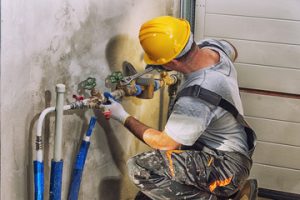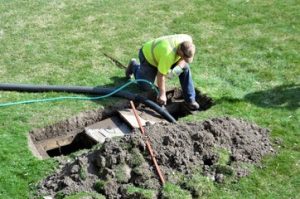Water runs silently beneath the surface of modern living. Plumbing, once seen as a background system, is now an evolving field of innovation and sustainability. It connects technology, design, and environmental care in ways that redefine comfort. The unseen pipes have become the arteries of sustainable homes.

The foundation of every building depends on efficient water movement. Modern plumbing now integrates intelligent monitoring systems that track usage and detect leaks instantly. These advancements prevent water waste and reduce maintenance costs. The network below floors has become a living system that thinks and adapts. Visit Website to learn more.
Smart plumbing introduces a layer of convenience never seen before. Sensors identify small issues before they grow into major problems. Homeowners receive real-time notifications about pressure changes and flow irregularities. This proactive approach replaces reaction with prevention.
The materials used in plumbing have evolved too. Traditional metal pipes are being replaced by flexible and corrosion-resistant alternatives. These new materials improve flow efficiency and minimize contamination risks. The balance between strength and flexibility drives progress in pipe design.
Water conservation lies at the heart of the industry’s transformation. Low-flow fixtures, precision valves, and optimized routing reduce unnecessary water consumption. Plumbing design now contributes directly to environmental sustainability. It shapes the balance between modern convenience and ecological responsibility.
Greywater systems are reshaping residential infrastructure. They recycle lightly used water for irrigation and cleaning purposes. This innovation reduces demand on freshwater supplies and lowers utility costs. Plumbing now acts as both a resource and a solution.
The demand for energy-efficient heating has expanded plumbing’s role. Systems that combine heating and water circulation offer improved comfort with reduced energy use. Pipes are now designed to retain warmth for longer periods. Efficiency no longer sacrifices luxury.
Urban development challenges plumbing systems differently than rural areas. High-rise structures require pressure-balanced distribution and advanced drainage engineering. Plumbing in modern architecture is an invisible framework that sustains vertical living. The complexity behind simplicity continues to grow.
Sustainable building codes push plumbing design toward greener solutions. Innovations in water metering encourage mindful consumption. These systems promote accountability and awareness. Every drop saved contributes to a collective environmental effort.
Leak detection has evolved from guesswork to science. Acoustic sensors and microcameras pinpoint pipe damage with surgical precision. This reduces excavation, cost, and downtime. Plumbing repair has become a sophisticated practice driven by accuracy.
Hygiene remains a central concern. Contactless faucets and self-cleaning drainage systems have become standards of safety. These technologies reduce contamination risks in both homes and public facilities. Plumbing now guards health as much as it delivers water.
Pressure management is a fine art within plumbing systems. Too much can rupture pipes, too little affects usability. Modern regulators adjust flow automatically depending on usage. Consistency and safety flow together in every drop.
Sewer and drainage systems receive equal innovation. New filtration units prevent blockages and protect waterways from pollutants. Waste management now merges with environmental ethics. Plumbing ensures cleanliness beyond the walls of a home.
Noise reduction has become another frontier. Quiet piping and flow-controlled fittings eliminate disruptive sounds. Living spaces benefit from silent efficiency. Peace accompanies functionality in modern plumbing design.
Underground plumbing faces challenges unseen but critical. Soil movement, moisture changes, and pressure variations all affect pipe stability. Reinforced joints and flexible couplings address these dynamic conditions. Durability meets adaptability below the ground.
Remote monitoring makes maintenance seamless. Technicians can assess performance from digital dashboards without site visits. Predictive analytics forecast potential system stress points. Data-driven plumbing ensures reliability over time.
Water quality monitoring has become an integrated function. Sensors detect contaminants or irregular mineral levels instantly. These systems protect households from invisible risks. Safe water is now an automated guarantee, not a hopeful outcome.
Temperature control has gained new precision through thermostatic valves. They maintain steady flow conditions even during fluctuating supply. Comfort becomes predictable and secure. Plumbing merges mechanics with intelligent design.
The environmental footprint of plumbing materials is under scrutiny. Recycled composites and eco-safe insulation are now common. Manufacturing processes are designed to reduce carbon impact. Plumbing materials are becoming as green as the systems they build.
Modular plumbing accelerates construction efficiency. Pre-assembled sections reduce installation time and minimize human error. Consistency improves while waste decreases. Innovation simplifies complexity without sacrificing performance.
Corrosion prevention extends lifespan and reliability. Coatings, liners, and advanced alloys prevent metal decay. Water purity stays intact through stable infrastructure. Durability ensures long-term peace of mind for both builders and users.
Digital blueprints streamline system design. Engineers simulate flow behavior before installation begins. This prevents layout inefficiencies and reduces post-construction issues. Planning precision translates into lifetime reliability.
Smart water heaters connect seamlessly with modern plumbing systems. They adapt to usage patterns, saving energy without compromising comfort. Automation aligns with daily routines effortlessly. The result is intelligent living powered by water control.
Rural plumbing is evolving with solar-assisted pumping systems. These setups bring sustainable water access to off-grid communities. Renewable energy supports basic comfort while preserving resources. Plumbing becomes a tool for equitable development.
In commercial spaces, plumbing innovations manage large-scale consumption responsibly. Recycling systems capture and treat used water on-site. This reduces dependency on external supply networks. Industry adapts sustainability at every pipeline.
Microbial control technology addresses hidden dangers in stagnant water. Systems now circulate water at intervals to prevent bacterial growth. This reduces the risk of biofilm formation. Health and technology unite for safer plumbing.
Insulation plays a crucial role in climate adaptation. Properly insulated pipes maintain water temperature and prevent freezing or overheating. It enhances comfort and conserves energy simultaneously. Efficiency flows quietly through thoughtful design.
Rainwater harvesting integrates with existing plumbing networks. Captured water is filtered and redirected for non-potable uses. This system eases strain on traditional supplies. Nature and engineering collaborate through these cycles.
Maintenance accessibility has improved through smarter layout planning. Service points are positioned for quick repair and inspection. Reduced disruption keeps systems running efficiently. Every joint is designed with future access in mind.
Automation influences plumbing’s future deeply. Self-regulating systems adjust to environmental and user changes. They optimize pressure, flow, and temperature without manual control. The plumbing network becomes a responsive ecosystem.
Modern homes feature zoned water systems. Different areas receive distinct pressure and temperature settings. This customization enhances comfort while saving resources. Plumbing adjusts to human patterns like a living organism.
Emergency shutoff systems now act within seconds of detecting leaks. This minimizes water loss and prevents property damage. Integrated AI identifies irregularities before they escalate. Plumbing protection has reached predictive intelligence.
Material science continues to refine performance. Flexible piping that withstands expansion and contraction enhances safety in fluctuating climates. Durability no longer requires rigidity. Movement and stability coexist harmoniously.
Design aesthetics even influence visible plumbing components. Faucets, drains, and fixtures follow minimalist trends. Form meets function without compromise. The technical becomes part of interior beauty.
Education in plumbing practices is evolving rapidly. Training now involves digital modeling, automation systems, and environmental compliance. Skilled professionals combine craftsmanship with technological fluency. The new plumber is both artisan and technician.
Wastewater recovery systems add another layer of sustainability. They purify and repurpose outgoing water for industrial or irrigation use. Nothing is wasted when technology redefines flow. Circular water systems embody the future of plumbing ethics.
Emergency resilience has become part of modern planning. Plumbing must endure floods, droughts, and natural disruptions. Flexible designs and adaptable components ensure continuity. Preparedness becomes as vital as efficiency.
The industry’s next step focuses on zero-leakage technology. Seamless connections and self-sealing materials eliminate water loss. Every joint becomes a seal of reliability. The goal is perfection through innovation.
Home automation merges with plumbing controls seamlessly. Voice and mobile commands adjust temperature, flow, and conservation settings. The luxury of control meets sustainability. Water use becomes as intelligent as energy consumption.
Long-term monitoring provides insights into usage trends. Data collected from smart meters supports conservation campaigns. Understanding patterns leads to mindful living. Plumbing becomes both infrastructure and education tool.
Even aesthetics in exterior systems are considered now. Concealed piping, clean lines, and integrated valves maintain visual harmony. Function no longer disrupts design. Plumbing contributes quietly to architectural balance.
Modern innovations ensure that plumbing remains both invisible and indispensable. Beneath the walls and under the floors lies a system that breathes life into comfort. Every advancement reflects a desire for efficiency, safety, and sustainability. The art of plumbing flows forward into a smarter, cleaner future.

